
![]()
Search the Journey to Forever website – click HERE
|
Journey to Forever: Make a donation |
Navigation
| Small farms library | |
| City farms | |
| Organic gardening | |
| Journey to Forever organic garden Handmade soil Village development |
|
| Why organic? | |
| Do it for selfish reasons No pesticides Food quality |
|
| Building a square foot garden | |
| Where to build it Is the soil fertile enough? Raised beds and double-digging The lazy way Paths The sides Sizes and shapes Trellises Cement Soil No compost? |
|
| Plant spacing guides | |
| No ground? Use containers | |
| Container gardening guide Resources |
|
| When to sow what | |
| Sowing times for different regions Seed sowing and harvesting times for Hong Kong Vegetable Garden Calendar for Hong Kong |
|
| Seeds | |
| Catalogs Supplies Herbs Hong Kong |
|
| Garden pond | |
| Pond resources | |
| Gardening resources | |
| Organics resources | |
| Square foot gardens | |
| Companion planting | |
| How much to grow? | |
| General gardening | |
| Herbs | |
| Composting | |
| Small farms | |
Contact usTo Keith Addison Handmade Projects |
Organic gardening
– "Organic gardening is not just a middle-class hobby. It's part of the wider environmental movement, it's part of a sustainable future. I believe that you could feed the whole world using organic methods." -- Jackie Gear, Executive Director of the HDRA, Britain's Organic Association, 1991.
– "The truth, so effectively suppressed that it is now almost impossible to believe, is that organic farming is the key to feeding the world." – "Biotech has bamboozled us all -- Studies suggest that traditional farming methods are still the best", The Guardian, August 24, 2000
http://www.guardian.co.uk/lifeandstyle/
2000/aug/24/foodanddrink.ethicalfood
– "Organic farming could produce enough food to feed large populations, according to British scientists at the Festival of Science in Sheffield." – "Organic farming can 'feed the world'", BBC Science, September 14, 1999
http://www.purefood.org/Organic/orgfeedworld.cfm
– "Feeding the world?" Quietly, slowly and very significantly, sustainable agriculture is sweeping the farming systems of the world – Jules Pretty, Director of the Centre for Environment and Society at the University of Essex, examines the myths and realities of sustainable farming's quiet revolution.
http://members.tripod.com/~ngin/article2.htm
– "It sounds like an environmentalist's dream. Low-tech 'sustainable agriculture', shunning chemicals in favour of natural pest control and fertiliser, is pushing up crop yields on poor farms across the world, often by 70 per cent or more. But it's no dream. That's the claim being made in the biggest ever survey of green-minded farming. The findings will make sobering reading for people convinced that only genetically modified crops can feed the planet's hungry in the 21st century. The gains are greatest among poor farmers..." – "The greener revolution", New Scientist, 3 February 2001
Journey to Forever organic garden
There was no garden at the Beach House before, just a big cement patio overlooking the sea, and under the cement, three metres of beach sand. The Beach House garden demonstrates that you can build a beautiful organic food garden even on cement without any soil – you make your own high-quality soil by composting food scraps with crop wastes and other waste-products. This waste recycling system is clean, hygienic and nuisance-free, and proven to be safe for children and in the home. This growing system is ideal for schools gardens and as a resource for school biology and environment projects. Why do small farmers need kitchen gardens? Because they help to ensure the family's food security. Like most Journey to Forever projects, the emphasis is on a mix of technologies. Gardening is an ancient art with a great heritage, and gardeners haven't mechanized like farmers have – they still tend each plant one by one, the same old tried-and-trusted way. The square foot system just makes it easier. The key is to make the soil fertile enough to keep pushing up that many healthy plants – square foot gardens need rich soil, at least 12 inches deep (these beds "grow" themselves deeper), or 16 cubic feet per unit.
We built an experimental garden at our base at the Beach House in Hong Kong, an interesting mix of Square Foot Gardening and Container Gardening, advanced yet simple and flexible organic growing systems. Though initially developed mainly for city-dwellers (parts of our garden came from a scaled-down version used in a 450-sq-ft 19th-floor city flat with no balcony), we'll be using these methods very far from cities.
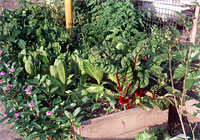
Part of the Journey to Forever garden
These systems need less space and less work, they're cheap, and they produce high yields of top-quality food.
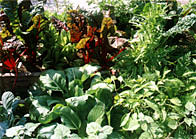
Brimming with healthy vegetables
One square foot garden unit measuring only 16 sq ft holds an average of 130 plants and produces enough high-quality vegetables for one person. It doesn't have to be a single unit, two half-sized units will do just fine – or whatever fits.
– "The square foot garden is divided into a size and shape that gardeners of all ages, sizes, and levels of experience can understand and cope with easily. The system is simple but versatile. It can be adapted to fit all kinds of gardening situations" – Mel Bartholomew, author of "Square Foot Gardening" (1981)
A stunted umbrella tree (Elephant's Ear) was trying to grow in a hole in the cement, with some old bathtubs and tyres standing here and there where a previous tenant tried raising some vegetables. But most of the soil in them washed away in the rains.
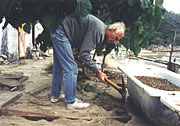
Keith digging through the cement patio to build the growing beds
Soon we had tons of fertile soil in deep, raised no-dig growing beds and hundreds of happy looking plants growing in them, with scores of varieties in square feet in the beds and in the containers. Our tomatoes grew more than 12 feet tall!
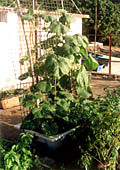
Squashes growing in a bathtub
Bananas and papayas grew in big baskets and large Chinese dragon pots, a mulberry cutting grew to a three-metre tree in a sunken bathtub, squashes and gourds in baskets and another bathtub grew up old bamboo ladders onto the kitchen roof. Sweet potato vines sprawled over the patio from a bed made of old logs on top of the cement. A variety of greens, bush beans, dwarf peppers and cherry tomatoes thrived in special one-square-foot baskets – a novel way to start your own portable garden.
The garden attracted lots of hardworking bees, many sorts of butterflies, toads to eat the bugs, and a lot of different birds – a rich, balanced ecology.Handmade soil
If you have garden space, so much the better – this is how to get a LOT of good, healthy food out of a very small area with a minimum of fuss.
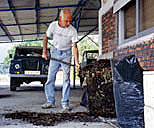
Turning a compost pile at the Beach House
If you only have a balcony or a roof, you can build a container garden. If you don't even have that you can make a window garden, and extend it by using grow-lights in the odd spare corner, and still grow a lot of your own food.
Whatever your situation, you can still make your own organic soil out of food scraps, grow your own healthy food, and do your bit to reduce waste.
– "You can raise a surprising amount of food on your roof, deck, patio or windowsill. The rewards can be large, even if your space is small" – Chuck Crandall and Barbara Crandall, "Movable Harvests" (1995)
Other settings
In the US the Square Foot Foundation is working to get a garden in every school, with Internet resource links promoting inter-school collaboration and providing expert support.
In Britain the HDRA's Schools Organic Network is helping schools to start and manage organic gardens for education. "Today's children could be forgiven for thinking that bananas come from boxes, peas come frozen in packets, and tomatoes from tins. The real origin of these foods -- that they come from living plants which grow in the soil -- is not apparent."
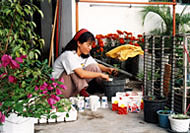
Midori transplants seedlings, using yoghurt pots, paper cups and milk cartons.
http://www.hdra.org.uk/schools_organic_network/index.htm
Our food-growing and waste-recycling system can also be easily adapted to the community gardens we plan to start in towns along our route.
And the garden served as a test-bed for some of the techniques and approaches we'll use in village rural development projects.
Village development
There have been cases where development efforts have succeeded in increasing farm yields and productivity but this has led to a decrease in the family's nutritional status. In many societies weeding is "women's work", and more crops meant more weeding, and less time to tend the
family vegetable patch (also women's work), and therefore less food for the children.
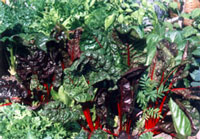
Close spacing creates a living green mulch to protect the soil.
Square foot gardening is an engineer's solution to the problem of how to grow enough food for your family with the minimum waste of space, time, work and resources while getting the best results.
One square foot garden unit measuring 4ft x 4ft – only 16 sq ft – will produce enough high-quality vegetables to feed one person every day.
We'll try to build at least two of them everywhere we go, in addition to whatever other work the local communities want us to do for them.
UPDATE

All the local villagers liked our garden
Since we wrote this we've found that other groups are using this approach, and it's very effective:
"In Kenya, the Association for Better Land Husbandry found that the farmers who constructed double-dug beds in their gardens could produce enough vegetables to see them through the hungry dry season. According to a review of 26 communities, 75% of the households are now free from hunger during the year, and the proportion of households buying food fell from 85% to 11%." -- Alternative Models (or Approaches) to Food Production, by Jules Pretty and Rachel Hime, University of Essex, UK, Jean Marc von der Weid, AS-PTA, Brazil, October 2001
http://www.forumfoodsovereignty.org/ingleseweb/
documenti_forum/documenti_base/alternative.htm

Rows are for tractors -- it's hard to see how they benefit gardeners. We planted a deep growing bed in circles. Circle-planting optimizes companion planting, successions and plant spacings for different plants. It's highly productive but needs a very fertile soil, and it's much more complex than square foot gardening
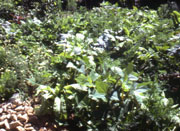
The circle bed in full production -- high yields of top-quality vegetables and herbs
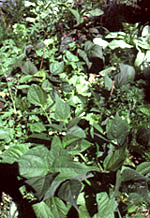
Different crops grow well together -- high fertility allows for close spacingTechnology
Many of the local villagers in Lantau still grow their vegetables the old way, and at first they were sceptical of our garden, with all that sand underneath. But when they saw the results they thought it was great, they kept saying so.
The square-foot idea is easy to grasp. Any farm women only has to see a square foot garden to understand how the system works, and can easily adapt it to local crops and conditions: deep, no-dig, raised beds; a different crop in each one-foot square; small plants in the front (facing the sun), bigger ones in the middle, climbers up a trellis at the back.
Apart from a companion planting chart (some plants love each other, others hate each other), a plant-spacing chart showing how many of each species to plant in one square foot, and a cropping calendar, that's really all you need to know.
Soil fertility
So we'll also build a compost heap, about a cubic yard in size, more than enough after it's shrunk during the process. Rapid bacterial breakdown will drive the temperature inside the heap well above 60 deg C within a day.
It will be ready in about a month, having turned into rich, black, crumbly stuff that looks nothing like its origins and has a clean, earthy smell – the ideal soil, no need for expensive chemical fertilizers!
City farms
Organic gardening
Why organic?
Building a square foot garden
Plant spacing guides
No ground? Use containers
When to sow what
Seeds
Garden pond
Gardening resources
Composting
Making compost
Composting resources
Composting indoors
Vermicomposting
Humanure
Composting for small farms
Small farms
Small farm resources
Community-supported farms
Farming with trees
Farming with animals
Pasture
Pigs for small farms
Poultry for small farms
Aquaculture for small farms
Composting for small farms
Controlling weeds and pests
Small farms library